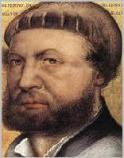

In 1528, he returned to Basel, where he painted portraits and murals and publicly took up Protestantism. In 1532, he left his wife and children forever, in spite of generous offers to reunite them, and traveled again to London, where he became court painter to Henry VIII. His services were much desired, and he produced more than 100 portraits. He also designed the king’s clothing and made inventory drawings of items used by the royal household.
In 1539, Henry VIII had enough confidence in Holbein that when he was thinking of marrying Anne of Kleve he sent Holbein on a mission to the continent to visit her and execute a realistic portrait for his scrutiny. In 1543, Holbein was still in London after 11 years and working on another portrait of the king when he died, a victim of the London plague. Holbein was one of the greatest portraitists and most exquisite draftsmen of all time.